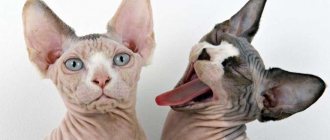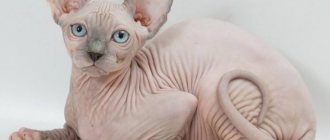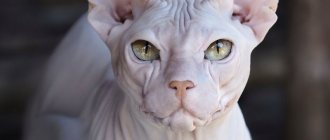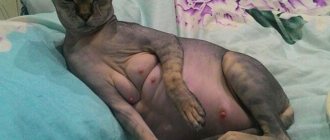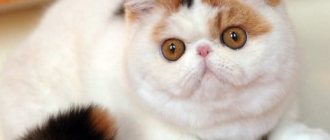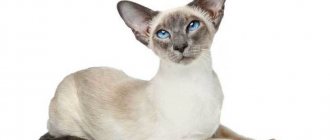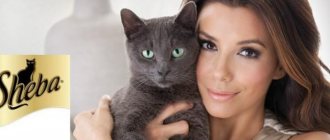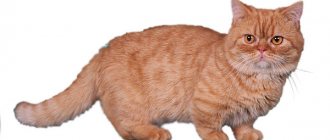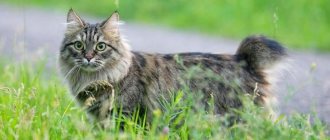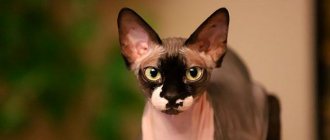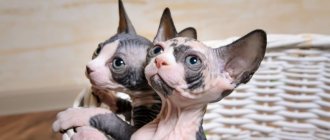The Sphynx cat is considered a unique animal, despite the fact that many are repulsed by their appearance and do not evoke pleasant associations with furry pets. The main difference from other cat breeds is short or completely absent hair. Sphinxes are rightly considered one of the most ancient breeds, representatives of which were found back in the days of the pharaohs. They can be called the same age as the great Egyptian pyramids.
In those days they were considered sacred and protected by laws. The life of cats was valued much higher than the life of a slave; they were worshiped and sought to please. Of course, in our time it is unlikely that sphinxes are deified anywhere else, but they still have a sophisticated expression on their faces, a piercing, attentive gaze and devotion to their owners.
White Sphynx kitten.
Origin story
The most popular varieties of sphinxes are:
- Canadian;
- Peterbalds or St. Petersburg;
- Don;
- Devon Rex;
- Cornish Rex.
They owe their names to the places where the first individuals of these breeds were discovered.
The first mentions that have come down to us are found in historical chronicles of the 4th century. BC e. In Ancient Egypt, they were endowed with the ability to communicate with the gods, as well as the dead who had gone to the afterlife. According to one version of origin, these cats descended from the hairless Mexican cat, tamed by the ancient Aztecs many thousands of years ago. Modern Sphynxes have their own history, each type of breed has its own history. Canadians arrived in Ontario in 1966. The first representative's name was Prune. Breeders managed to breed healthy kittens, which marked the beginning of the widespread distribution of Canadian Sphynx cats around the world.
In 1975, in the USA, in the city of Vaden, a kitten named Epidermis was born. In 1976, another hairless cat appeared here; these animals became the founders of the Canadian breed. Breeders and breeders will soon receive registration and standardization of the new breed from international felinological organizations.
Don Sphynxes are not genetically related to Canadians; they are an independent breed that appeared in Rostov-on-Don in 1987, that is, more than thirty years ago. A woman picked up an ordinary stray cat from the street and sheltered it in her home. After some time, the cat completely lost its fur. Veterinarians were unable to detect any health problems and attempted treatment for shingles, but this was unsuccessful. The cat brought three kittens, completely hairless. Only a girl survived, who received the nickname Chita. She is considered the founder of this breed. The breed received its official recognition, as well as approved appearance standards, in 1996.
The St. Petersburg Sphynxes owe their origin to the professional felinologist M. Mironova. She crossed the Don Sphynx with an Oriental cat. This happened in St. Petersburg. The kittens received the gene responsible for the absence of hair from their father, and from their mother - the features of their physique, paws, and skull shape. They received official registration from WCF in 2003. Each breed has its own history of origin, however, the general description of the Sphynx is the hairlessness gene, which all representatives have. Geneticists have their own version of its appearance - a spontaneous mutation of an animal gene that occurred in different places and at different times.
Peterbald is cream colored.
First mentions
We find the earliest information about cats lacking hair in antiquity, the annals of Egypt and the legends of the ancient Aztecs. There is reason to believe that they are descendants of a extinct breed - the Mexican Hairless, whose representatives finally disappeared in the 19th century. Its characteristic features were:
- long body;
- wedge-shaped head;
- long mustache;
- fur on the back and tail, disappearing in summer;
- amber colored eyes.
There are also known references to the Egyptian sphinx, figurines of which are found in the tombs of the pharaohs. According to legend, they were intermediaries between the world of people and gods, guarding the entrance to the tomb of the pharaohs.
Description of the breed
All Sphynx cats have developed muscles and delicate skin. The head has large ears that resemble locators, and the eyes have a slight slant. All sphinxes have a high body temperature, this is a feature of the animal’s heat exchange; in this case, it is not necessary to contact a veterinarian. The average height of a cat is 30-40 cm at the withers, and its weight is about 5 kg. There are general standards that the entire Sphynx breed has. They also apply to all representatives of hairless cats.
You can read about the Burmese cat breed and its colors here.
Appearance and standards
There are basic features of the Sphynx breed, approved by international organizations, which breeders and nurseries involved in breeding these cat breeds must adhere to. The characteristic features of the sphinxes are:
- The head is of medium size, in the shape of a rounded wedge, the length should be greater than the width. The forehead should be flat, with a smooth transition between the bridge of the nose and the forehead. The muzzle itself is short with high cheekbones and clearly defined boundaries. The chin should be strong, creating a perpendicular line with the upper lip. The whisker pads are well defined, but the whiskers themselves (vibris) may be completely absent.
- Ears. They are the main objects of attention. They are large in size compared to the head. They are erect and open, with a wide base. The inside should have no fur at all.
- Eyes. Large, almond or lemon shaped. They have a narrowing on both sides, planted far apart. The color of the iris can be any, but must be in harmony with the overall color.
- The animal's neck is of medium length and has the shape of an arc with developed muscles.
- Body. It is of medium length with a developed wide chest, round in shape. The belly is also rounded. The back of the animal is rounded.
- The legs are of medium length and should be in proportion to the rest of the body. In this case, the hind legs are slightly longer than the front ones. The paws are oval in shape and have long toes on all limbs.
- The length of the tail corresponds to the general proportions of the body, with characteristic flexibility and grace, gradually tapering towards the end.
It is by these criteria that one can determine the purebredness of the breed, as well as determine the quality of the pedigree.
Canadian Sphynxes.
Coat and colors
The Sphynx's skin is thicker than that of other cats and has numerous folds. There are especially many of them on the face and paws. Outwardly, the animal looks completely bald, but in fact there is a small fluff on the skin, several millimeters long. The fur may be on the outside of the ears, between the toes, and on the scrotum. There is a classification of Sphynx fur, dividing it into different types:
Naked. Such animals are already born naked and are considered the most expensive and rare; they are highly valued by breeders. There is homozygous and undressed. The latter have an inconspicuous fluff that quickly disappears.- Flock. This coat is soft to the touch, very short and almost invisible. Sometimes it can disappear completely.
- Velours. This type of cover can be felt when you touch it, but the cat appears naked. To understand that a cat has a covering, you need to stroke it. Once a year the animal sheds. There are three types of velor - light, velor-point, down.
- Brush. The animal is born with dense, curly hair, the whiskers are curled. There are three types of brushes - brush velor, point, dense.
- Straight-haired. Such an animal has the fur of an ordinary cat, but the physique and character of a sphinx.
The Sphynx can be any color. These are all types of colors that are found in all cat breeds - solid, tortoiseshell, tabby and others.
What types of sphinxes are there?
Sphynxes can be very different; there are varieties of Sphynx breeds (Canadian, Don, Peterbald and others), according to the cover and structure of the coat (nude, flock, velor, brush, straight-haired).
Table of the main differences between the varieties of the Sphynx breed.
Based on this classification developed by felinologists, it becomes clear about the condition of the animal’s fur. Hairless animals are considered the most valuable individuals among breeders and breed lovers. The cost of such kittens is higher than that of others.
Naked Sphinx.
Flock.
Velours.
Brush.
Straight-haired Sphynx.
Is it true that there are no allergies to hairless cats?
This is one of the most common misconceptions associated with these animals. Many are sure that Sphynx cats do not cause allergies. In fact, allergies to Sphynx dogs exist. Firstly, Sphynx cats have fur that also sheds, causing problems for allergy sufferers. Secondly, this reaction is caused by the skin secretion that these animals secrete. This breed has an increased ability to do this.
Exterior of an Egyptian cat
Sphynx cats are medium-boned cats that reach a weight of 5-7 kilograms. Despite their slight build, they are quite strong and muscular. Cats have a broad chest, a prominent belly, long legs and a thin, whip-like tail. The main distinguishing feature of the Sphinx is its fur, or rather its absence. The fur on the Sphynx's skin is so thin and short that it cannot be seen or even felt when stroking the cat.
In rare cases, pubescence is noticeable on the ears, muzzle, tail, paws and in the groin area of the animal. Patterns and colors may vary between cats as their color depends on the degree of skin pigmentation. Cats do not always have whiskers and eyebrows. The skin is quite wrinkled, especially in the head, neck and shoulder girdle. Because of this, animals always retain their characteristic “sullen” appearance. Some even believe that Sphynx cats are the scariest cats, but there are thousands of people who consider their unusual appearance elegant and aristocratic.
Other special features include the following exterior characteristics:
- wedge-shaped head;
- wide set large ears;
- prominent cheekbones;
- expressive oval-shaped eyes.
Raising a pet
Such cats have developed intelligence; they quickly understand what is required of them. In addition, the character of the Sphinx makes him obedient, attentive, and unforgiving. It is better to prevent negative consequences with cats in advance. Raising such animals is simple, but using punishment is impossible. They do not submit to physical pressure and do not tolerate mental violence well. It is extremely difficult to achieve anything from a cat using such methods. It is necessary to start raising a kitten in early childhood, the earlier the better. But you can start training at a later age.
Intelligence
All Sphynx breeds are easy to train; their memory, logic and character are sometimes equated to the level of trained dogs. After several trainings, the animal is able to perform tricks: it will bring small objects to its owner in its teeth, learn to open doors, drawers and even the lid of a washing machine. Kittens remember their name the first time.
These creatures are naturally very inquisitive and sociable, which allows them to socialize easily. An unusual pet will definitely make friends with all members of your family; they cannot stand conflicts.
- Author: Elena Romanenko
Rate this article:
- 5
- 4
- 3
- 2
- 1
(8 votes, average: 2.9 out of 5)
Share with your friends!
How to care for a Sphynx
You can train your Sphynx to use the litter tray simply by showing him the right place to go. Even if the kitten does not understand this the first time, the kitten needs to be shown again. If the owner notices that the cat begins to behave unusually and begins to look for a place, it is necessary to immediately transfer the kitten to the litter box. In general, caring for an animal does not have any special conditions. The main difference in caring for this breed is its coat. A cat sweats a lot due to its high body temperature - the cat needs to be bathed frequently, at least once a week.
These cats need to be wiped down daily. This is best done with wet wipes. Dead fur hairs are removed in the same way. Ears and eyes should be cleaned periodically. To do this, you can use cotton swabs soaked in warm water. Once a week, it is important to wipe your eyes with a damp cotton pad to remove discharge from the tear ducts. You can use chamomile infusion or weakly brewed tea.
There are some requirements for swimming:
water temperature should be 36-38 degrees;- During the procedure, you need to talk to the animal in a calm, pleasant voice so as not to cause stress and discomfort;
- It is better to bathe the animal in thick, dense foam;
- You can’t wash your hair so that water doesn’t get into your ears;
- After bathing, the cat should be wrapped in a towel and dried well.
Once a month it is necessary to brush your teeth. To do this, you need to purchase special brushes. It is also necessary to cut your nails regularly. This breed is distinguished by long claws that require special attention.
Where did you come from
The history of Sphynx cats dates back to ancient times, when the Aztecs bred hairless cats. This species soon became known as the “Mexican hairless.” He was the progenitor of those whom we now call “sphinxes.” The name of the breed is a direct reference to its ancient origins.
In the 60s in Canada, a “freak” appeared in a cat’s litter. It was a hairless kitten. The strange creature became the object of experience. When he grew up, he was crossed with his mother, and the next offspring produced even more hairless kittens. As a result, many hairless ones were born until the breed was completely established. According to another version, everything happened in the mid-70s. In one litter a hairless cat was born. The cubs were crossed, and they became the founders of a new breed. In the mid-70s, three hairless cat cubs were found in Toronto - one boy, two girls. The male was very weak. The kitten's eye was leaking and her reproductive organs were damaged.
The boy was taken out, he stood on his paws and received the name “Bambi”. This sphinx is the record holder for the longest life span among bald ones; he lived for 19 years.
Health and life expectancy
The average life expectancy of sphinxes is 12-15 years.
Following the requirements of proper nutrition and a balanced diet, these cats rarely visit veterinary clinics. Health problems are often caused by hypothermia and poor hygiene. Problems may arise due to the animal's prolonged exposure to sunlight. However, there are diseases characteristic of sphinxes - urticaria, various skin irritations, rashes. For them, one of the health problems is hypertrophic cardiomyopathy.
With it, the septum between the ventricles of the heart suffers. However, geneticists have no evidence that it is associated with poor heredity. Another disease is myopathy - it is inherited. This disease is common in Devon Rex dogs. The Sphynx's body temperature normally reaches 39 degrees, which is much higher than that of other cat breeds.
Diseases of hairless cats
Diseases of hairless pussies primarily include acne. Most often it occurs in blue and red cats. If acne appears, it can be easily cured with the help of special medications.
Allergies are also common among bald people. Moreover, it can be for anything: detergents, flowers, fabrics. You can get rid of it only by eliminating the source.
During estrus, cats sometimes develop seasonal dermatitis. But, as a rule, it passes as quickly as it begins.
Unlike common and easily treatable diseases, hairless cats suffer from hereditary diseases that are almost impossible to cure: gum hyperplasia, carp bite, underdeveloped tail vertebrae, respiratory tract obstruction syndrome. There are also defects of the eyeball (the eye has to be removed) or entropion of the eyelids, which requires surgical intervention. In females, nipple hyperplasia and mammary gland diseases are sometimes observed.
Cats sometimes give birth to kittens that begin to “sleep” two weeks after birth. The babies practically fade away before our eyes and it is impossible to save them, and the reason lies in an abnormality of the thymus.
Despite this “bouquet”, with proper care, cats live on average 14-15 years, and can only suffer a mild cold in their entire life.
Features of mating and pregnancy
The first estrus in females begins at 6 months, but mating with a cat during this period is not possible, since the hormonal background has not yet formed. The male becomes fully sexually mature by 8 months. They can be brought together only after the girl’s third heat, that is, at about 1.5 years. In this case, the probability of obtaining healthy offspring is maximum. Before estrus, both animals must receive all the necessary vaccinations and carry out grooming procedures with their claws, otherwise they may damage each other during the mating process.
It is prohibited to cross different types of sphinxes, for example, a Canadian with a St. Petersburger. In this case, the probability of getting sick and non-viable kittens is almost 100%. The first signs of pregnancy in a cat are noticeable in the third week. The nipples become deep pink, and the belly begins to increase in volume. Pregnancy lasts 65 days. In about a week, you need to prepare a place for her where the cat will give birth. This should be a quiet, secluded place, with warm and soft bedding. There are approximately 4-6 kittens in the litter.
Maintenance and nutrition
Sphynxes are sensitive to cold and drafts. It doesn't matter whether the Sphynx cat is bald or the Sphynx cat is hairy. To protect hairless cats from colds, you need to take care of a warm wardrobe. Clothes for cats will also save you from burns if the sphinx decides to soak up the sun or bask near the radiator.
A description of Sphynx cats would be incomplete without mentioning one very unattractive feature. All sphinxes have different personalities. Among the usually calm sphinxes, there are individuals who constantly test their vocal cords on their master's nerves. The family has not yet had time to wake up in the morning, and the Sphynx cat is already yelling, demanding breakfast, yelling while waiting for the toilet, yelling, asking to go to bed, yelling, forcing him to play, yelling, because he has simply already learned and got used to yelling.
A constantly screaming cat interferes with rest, work, and sleep. Then the irritated and tired owners try to inexpensively place their “treasure” in kind and caring hands. Ads of this kind should be treated with caution, otherwise “almost free” cat concerts will continue in a new territory. It’s better not to tempt fate and adopt the Sphynx as a kitten from the nursery.
By their nature, sphinxes are rare gluttons. They are ready to eat always, everywhere and in large quantities. To prevent your pet from turning into a huge, shapeless monster and from acquiring gastrointestinal diseases, it is necessary to feed the Sphynx correctly.
First of all, meals should be carried out according to a schedule, two to three times a day, and in strictly limited quantities.
Until 1.5 months, you don’t have to think too much about what to feed the kitten. No supplements are required in addition to breast milk. 1.5 - 2 month old kittens are given light complementary foods in the form of porridge and egg yolk. From 3 months, pureed boiled chicken, veal and vegetables are gradually added to the diet, and they are introduced to ready-made food. New supplements can cause diarrhea, and this disease should be taken seriously and monitor which foods irritate the Sphynx's gastrointestinal tract.
Up to 3 months, 20–25 g of food 6–8 times a day will be sufficient. Next, you should transfer the cat to 2 - 3 - single feedings of 40 - 50 g. A pregnant cat needs to be fed more often. For an inactive sphinx of advanced years - twice a day. Breeders recommend using a combination diet, including wet and dry food with natural treats. A loving owner feeding his pet must remember strict gastronomic prohibitions.
You should not dilute your diet with fatty meats, raw fish, any bones, pickles, smoked meats, or sweets.
Pregnancy in a healthy cat is relatively calm. A pregnant Sphynx cat brings 2 to 5 charming “rubber” babies in a litter. Kittens are born blind, but already on the 3rd - 4th day they open their eyes. The ears open in 7–10 days and will be erect by the fourth week. Kittens can be born either completely naked or fluffy. The less fur newborns have, the “balder” the Sphynx will be when she enters adulthood. By the way, a hairless cat can give birth to hairy cubs, while a woolly cat can give birth to “naked” ones.
How to choose a kitten
When choosing a kitten, you need to pay attention to its health. Such an animal should show playfulness, activity, and curiosity towards a new person. He should not have any discharge from his eyes or ears. The release of eye fluid is allowed, but only transparent and odorless. Also, the new pet must have all the documents, which include its pedigree, veterinary passport, and current vaccinations, which the breeder must provide it with.
How much do Sphynx kittens cost?
Purebred kittens are purchased only in nurseries. Such organizations have all the documents and deal only with verified animals, buy sick or not purebred. A kitten without documents and history can be bought from advertisements on the Internet for just a few thousand. The price for animals from the breeder starts from 10,000 to 50,000 rubles.
Cost of a Sphynx kitten
Pet lovers who are attracted to cats without hair are interested in knowing what the average cost of a purebred Sphynx is. The answer to the question: how much does a Sphynx cat cost depends on the kitten’s belonging to a certain class. In particular, an exhibition Sphynx cat, which can only be purchased from professional breeders, can cost more than a thousand dollars. This pet meets all standards and can be used for mating.
Pet class kittens are more affordable. Such a Sphynx cat, the price of which is about 200 dollars, may have some defects in the exterior and is not allowed to participate in exhibitions. However, she will become a devoted pet for lovers of unusual cat breeds. In any case, the question of how much a Sphynx cat costs, the price of which is set by the breeder, is always discussed individually at the time of purchase.
Sphynxes are hypoallergenic cats that are distinguished by their peculiar disposition and unusual appearance.
In relation to strangers, sphinxes are reserved and cold - they can demonstrate complete disinterest, but at the same time they will never allow themselves to show aggression towards a stranger. These unusual cats reveal softer character traits to their owners - they become very attached to family members and demonstrate friendliness, tenderness and affection.
Interesting facts about sphinxes
This breed has many interesting stories about itself that they have acquired over their long history. Here are some facts about sphinxes:
- Sphynxes are very smart animals, but with a sensitive psyche. You can’t shout at them, much less hit them.
- These cats have a high appetite, which is associated with a fast metabolism and elevated body temperature.
- Many owners notice that in terms of their activity and ability to climb, they are similar to monkeys, and in terms of the degree of attachment to their owner, they are similar to a dog.
Due to the characteristics of the skin, all flaws in the figure are noticeable, especially excess weight gain. This breed has an increased tendency to become obese, so it is important to monitor the animal’s diet and body weight.
Interesting read: everything about the Balinese breed.
Sphynx cat character
In any home, the Sphynx cat will certainly become the favorite of the whole family. It can not be in any other way. After all, these hairless creatures are smart, curious, playful, friendly, and also completely devoid of aggressiveness. Pharaonic origin does not allow them to commit even small dirty tricks. Always being in the center of attention is a vital need for cats of this breed. The hairless cat will follow his beloved owner all day long, looking for an opportunity to sit comfortably on his lap.
They easily let children into their cat-like world, allowing themselves to be wrapped in diapers and vests, sent on an exciting journey, decorated and painted with paints.
In short, the dream of every little child. Sphynxes will add a sweet charm to a quiet family environment and will happily show off in front of guests. The funny eating of “sweets,” when the sphinx artistically takes food with her paw and puts it in her mouth, brings guests to indescribable delight and increases the number of fans.
Sphinxes become so attached to people that it is very difficult for them to endure separation. So that the pet does not suffer from loneliness and does not fall into cat depression, breeders advise acquiring some other pet animal. “Baldies” are quite sociable, they will quickly get acquainted and find a common language with both the newt and the parrot.
Advantages and disadvantages
When choosing a breed that you plan to get, the choice often falls on Sphynxes. But before that, you need to know everything about sphinxes, their differences, features, habits, and most importantly, their advantages and disadvantages. The main advantages of sphinxes are:
- activity;
- curiosity, but sometimes this can be considered a disadvantage;
- tenderness and affection;
- communication skills with people and animals.
The disadvantages include the need to frequently bathe the animal, otherwise it will dirty the furniture, leaving gray-yellow stains on it. They are also afraid of the cold; the owner must monitor the temperature in the apartment very closely. Sometimes a cat can get bored with a person due to over-attachment.
Reviews of hairless cats: what owners say about hairless pets
Some owners, when purchasing cats, do not go into the intricacies of the breed and have little idea of how, for example, a Sphynx differs from a Rex. Only after the kitten appears in the house is it truly appreciated. Moreover, upon closer acquaintance, people begin to like bald people more and more.
Frejdis
writes that she did not plan to have a pedalboard and knew nothing about these amazing cats until the pet appeared to her “by chance.” These animals are affectionate, intelligent and understand their owners well. The Peterbalds are real intellectuals, which is evident even from their looks. They quickly learn to follow commands and understand what not to do. The pet, for example, quickly realized that it was impossible to make noise when a small child was sleeping. It is also very important that cats do not shed, and you don’t have to pick up their fur all over the house.
https://otzovik.com/review_1073932.html
Krasotulya
I really appreciated the Ukrainian Levkoy after I took him into my home. The cat gives its affection to all family members, without singling out anyone. She never shows aggression. Although friends are surprised that one can love this alien creature, the owner is sure that her hairless family member cannot be compared with other breeds. My favorite immediately got used to the tray, doesn’t scratch, and understands everything right away. If anyone doubts whether to take the left one, the answer is clear - take it.
https://irecommend.ru/content/ya-byla-ravnodushna-k-semeistvu-koshachikh-poka-u-nas-ne-poyavilos-doma-eto-chudo
